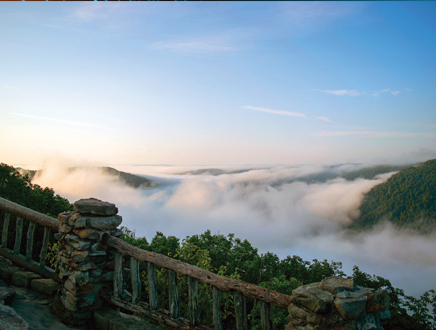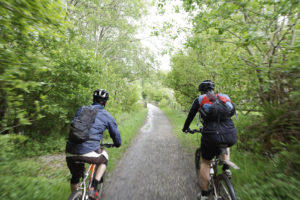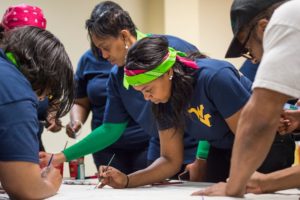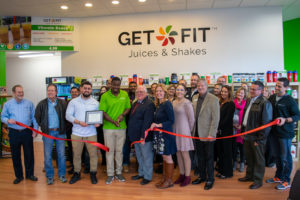By Samantha Cart
As one of the major growth areas in the state of West Virginia, Morgantown continues to diversify and thrive, thanks in part to the collaboration of local government and business organizations.

Morgantown is teeming with economic development. With the ongoing expansion of West Virginia University (WVU), WestRidge Business + Retail Park, Mylan Park and the Morgantown Municipal Airport, the city’s growing footprint is a bright spot in the Mountain State.
According to the North Central West Virginia Economic Outlook 2019-2023 report by the Bureau of Business and Economic Research at WVU, Monongalia and Harrison counties accounted for the bulk of the area’s economic growth over the past several years, and many of the region’s sectors have significantly outperformed statewide growth. With particular strongholds in health care, retail and leisure and hospitality, this progress can be contributed in part to the hard work and cooperation of several Morgantown business engines and organizations, including the Morgantown Area Partnership, the Visit Mountaineer Country Convention & Visitors Bureau (CVB), WVU and the City of Morgantown. Rather than working toward the same goals while operating independently, these entities have joined forces to work toward their shared interest of making Morgantown a destination to live, work and play.
Morgantown Area Partnership
In 2019, the Morgantown Area Chamber of Commerce, Monongalia County Development Authority, Morgantown Area Economic Partnership and Campus Neighborhoods Revitalization Corporation (CNRC) combined to form the Morgantown Area Partnership, a public/private alliance that works toward the betterment of economic, business and community development in Monongalia County.
“The Partnership’s unique position allows it to be involved at a much deeper level in the community,” says President and CEO Russell Rogerson. “We work closely with local government to assist in moving positively forward on issues important to community growth. We also have around 60 nonprofit members that make coordination much easier in the community. We believe collaboration among the public and private sectors leads to stronger, more sustainable solutions to challenges and opportunities.”
The Partnership supports a variety of initiatives in the community, including programming and promotions for Morgantown’s small businesses.
“The presence of WVU and its Encova Center for Innovation and Entrepreneurship has led to growth in an already entrepreneurial community,” says Rogerson. “Small businesses are collectively the largest employer in every area, so it is important to have the resources and support services to help them to be successful.”
Morgantown is home to a healthy mix of small businesses and large, private employers. However, what sets it apart from other cities is a shared sense of community and dedication to constant improvement.
Part of what makes the Partnership unique is the inclusion of the CNRC, or Sunnyside Up, a 501(c)(3) nonprofit that was created in 2002 as a collaboration between the City of Morgantown and WVU. Its purpose is to engage in developing, financing and implementing plans to eliminate blight, improve conditions and prevent the deterioration of neighborhoods. The CNRC has had great success in the Sunnyside area and continues to develop plans to upgrade, replace and build new infrastructure to meet the demands of Morgantown’s growth.
Visit Mountaineer Country Convention & Visitors Bureau

Part of that growth is due to the work of the Visit Mountaineer Country CVB. With its recent rebranding, it has been able to better accommodate its role as a destination marketing organization servicing Monongalia, Preston and Taylor counties.
The CVB supports all its partners in different ways, including the Morgantown Area Partnership.
“The CVB has worked closely with the Morgantown Area Partnership since its inception,” says CVB President and CEO Susan Riddle. “We are one of the founding investing partners, and we work with the Partnership to help attract and sell our destination to businesses, recruits and prospects as we are able.”
One of Morgantown’s strongest assets is its strong brand recognition, which easily lends itself to marketing the area.
“We all recognize and utilize that to the best of our abilities,” she says. “At the end of the day, Mountaineer Country is not just a great place to eat, shop, stay and play. It is a great place to live and raise a family. I couldn’t be happier to call Mountaineer Country my home.”
West Virginia University

According to Riddle, WVU is the engine that makes many of the wheels turn in Morgantown.
“In tourism, the most common question asked is what makes a destination unique,” she says. “That is easy for us to answer—we are the home of the WVU Mountaineers. The CVB is always seeking opportunities to strengthen our relationships within the WVU community. It is a destination unto itself.”
WVU is indelibly embedded into the economic, social and physical fabric of Morgantown, and as the university grows—whether in size, status or influence—so does its relationship with the city itself.
“We can’t be a strong university unless we take steps to make sure we are good partners,” says Rob Alsop, vice president for strategic initiatives at WVU. “The stronger the city is, the higher the ceiling for the university. There is a strong correlation between what goes on in the city and in the university. We’re not the only one, though. There are a number of businesses in town that are a vibrant part of the community. We are just one piece of the puzzle.”
Alsop is particularly proud of the university’s collaboration with the City of Morgantown on the Sunnyside Up project.
“For the past 15 years, the university and the City have jointly worked together on projects in the Sunnyside area,” he says. “Whether it is streetscapes or ways to improve the property for development, we work hand in hand with the City on those projects.”
City of Morgantown

As part of that collaborative effort, Emily Muzzarelli, PE, interim city manager for the City of Morgantown, believes the combined efforts of the city, WVU, the Partnership and the CVB are what make Morgantown a desirable place to live and work.
“Almost any public event or activity happening in Morgantown involves the CVB, and many times, the city is involved from a public safety and programming standpoint,” she says. “That relationship allows Morgantown to be rich in family-friendly, active and cultural public programs.”
Part of Muzzarelli’s work with these entities is focused on the city’s continued growth.
“As a community that is vastly built out, careful consideration for promoting the right kinds of development is vital,” she says. “In nearly all senses, Morgantown is a college town. We would not be the center for activity and growth if it weren’t for West Virginia University. Working together helps us keep the community one that works for all residents, both permanent and temporary.”
While the city is constantly working to accommodate for future growth, much of what is going on in Morgantown today is the redevelopment of existing space and resources, including plans to annex areas outside city limits and generate new streams of revenue.
“Morgantown has really great momentum to be incredibly innovative,” says Muzzarelli. “I think we will continue to focus on creating the right balance between keeping Morgantown wild and wonderful and creating an amazing place to live, eat and play in a more urban setting.”
A Community that Cares
West Virginia University (WVU) is a vital part of Morgantown’s culture, and a key part of that connection is a commitment to service. Morgantown residents and WVU students alike are dedicated to making the city the most accessible, most attractive and most welcoming it can be. The WVU Center for Service Learning (CSL) is one of many organizations where people can come together to make this vision a reality.
“The WVU Center for Service Learning is committed to building a campus and community that encourages social action connected to academic success, integrity and growth in civic responsibility,” says Dr. Kristi Wood-Turner, the center’s director. “We are making change in our community by finding innovative, effective and respectful ways to strengthen and build campus and community partnerships. We are teaching students how to take action to make positive changes and working with the community to help them tap into the diverse strengths of our institution.”
WVU students alone provide between 80-100 hours of community service every year through the CSL. The center’s database is also connected to the United Way of Monongalia and Preston Counties and the United Way of Marion and Taylor Counties, so community members—not just WVU students—can always find opportunities to serve.
“We work to find real community need, including opportunities presented to us from community members,” says Wood-Turner. “We see it as a part of our responsibility to work hard to find all need in the community large and small and leverage our resources to benefit the most people.”
Wood-Turner has been with the CLS since it was created in 2006, and she is most proud of the community partners program, which has grown from 12 to more than 220 partnerships and helps facilitate sustainable connections between WVU faculty and students and Morgantown’s residential community. The City of Morgantown, Morgantown Area Partnership and Visit Mountaineer Country Convention & Visitors Bureau are all official partners of the CSL.
“We work directly with these community agencies and pride ourselves in understanding missions and needs in order to make sustainable connections with faculty and students to advance their goals,” says Wood-Turner. “Our partners are fully committed to not only their own missions but to the growth and partnerships they create for our WVU family.”







